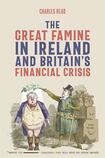
Through lack of understanding of macroeconomics and financial markets, a new UK government turns a fiscal and political challenge into a financial crisis, leading to an austerity-driven humanitarian catastrophe. The year is 1847, not 2022.
This is the core argument of Cambridge historian Charles Read’s The Great Famine in Ireland and Britain’s Financial Crisis. By exploring private correspondence of leading policymakers of the day and highlighting discrepancies with their public statements and historical perceptions, the author interrogates their underlying motivations. In the process, he nails a number of established myths.
As opposed to his folk persona as the villain of The Fields of Athenry, Charles Trevelyan is presented as a dutiful civil servant, faithfully implementing the policies of his political masters. Chief among the latter are Conservative prime minister Robert Peel, his Whig successor from 1846, John Russell, and the latter’s chancellor, Charles Wood. Rather than uncaring, free-market ideologues, these are presented as largely pragmatic and well-intentioned with respect to Ireland, but unable to secure a parliamentary majority for their desired policies. Nonetheless, their ideological commitment to the rigid gold-standard monetary policy experiment embodied in the 1844 Bank Charter Act was to prove ruinous for Ireland.
Read sets out the very significant famine relief policies pursued by both Peel and Russell governments, and makes a compelling case that these were reversed in 1847 only when financial markets took fright at attempts to finance their continuation through borrowing. Fears that borrowing to import foodstuffs would call Sterling convertibility into question precipitated a run on gold bullion at the Bank of England.
MobLand review: Pierce Brosnan’s Irish accent is a horror for the ages. Forget licence to kill, this is more Darby O’Gill
‘It is so expensive in Dublin we decided to rent’: Swedish embassy returns to capital
EU call to stockpile food and essentials: What would be in your 72-hour survival bag?
Adolescence in teenagers’ own words: ‘Parents have absolutely no idea’
Borrowing could have been avoided if income tax had been increased, but Irish MPs holding the parliamentary balance of power refused to countenance axing the exemption for Irish landlords. Those in Great Britain understandably baulked at paying more while the Irish elite paid nothing. Thus, the villain of the piece is less perfidious, but rather feckless, Albion, allied to Ireland’s own perfidious landlord class.
[ Catholic Church was a ‘net winner’ from Ireland’s Great Famine, historian saysOpens in new window ]
The Great Famine is based on the author’s multi-award-winning PhD thesis. Well-researched and extensively footnoted, Read’s prose is at times repetitive, while general readers may find the intricacies of mid-19th century monetary policy debates somewhat arcane. In particular, the contemporaneous counter-example of colonial Mauritius is germane to the underlying argument, but its chapter-length treatment seems excessive. The book nonetheless deserves a wide readership as a serious and balanced contribution to the Irish economic history canon.













